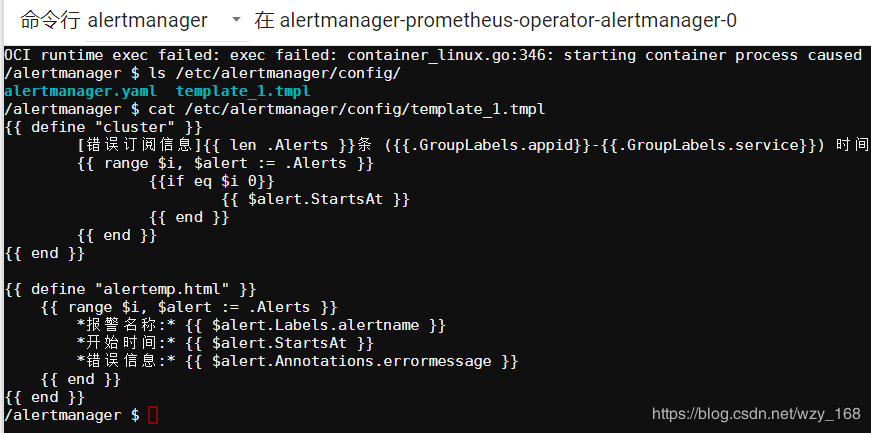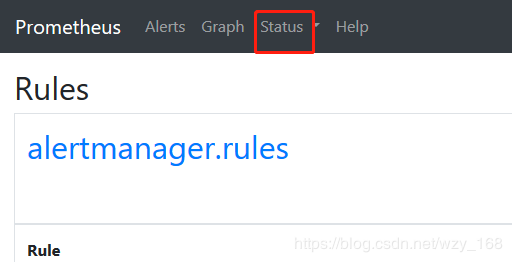Alertmanager简介及机制
Alertmanager处理由例如Prometheus服务器等客户端发来的警报。它负责删除重复数据、分组,并将警报通过路由发送到正确的接收器,比如电子邮件、Slack等。Alertmanager还支持groups,silencing和警报抑制的机制。
分组
分组是指将同一类型的警报分类为单个通知。当许多系统同时宕机时,很有可能成百上千的警报会同时生成,这种机制特别有用。
抑制(Inhibition)
抑制是指当警报发出后,停止重复发送由此警报引发其他错误的警报的机制。(比如网络不可达,导致其他服务连接相关警报)
沉默(Silences)
Silences是一种简单的特定时间不告警的机制。
默认配置
打开Alertmanager的页面,选择status页面,可以查看到当前的Config。这是使用Helm安装prometheus-operator时默认的配置,如何修改呢?
global:
resolve_timeout: 4m
http_config: {}
smtp_hello: localhost
smtp_require_tls: true
pagerduty_url: https://events.pagerduty.com/v2/enqueue
hipchat_api_url: https://api.hipchat.com/
opsgenie_api_url: https://api.opsgenie.com/
wechat_api_url: https://qyapi.weixin.qq.com/cgi-bin/
victorops_api_url: https://alert.victorops.com/integrations/generic/20131114/alert/
route:
receiver: "null"
group_by:
- job
routes:
- receiver: "null"
match:
severity: info
group_wait: 30s
group_interval: 5m
repeat_interval: 12h
receivers:
- name: "null"
templates: []
Alertmanager配置说明
参考https://www.jianshu.com/p/239b145e2acc
修改默认配置
默认配置由同命名空间下Secret挂载到POD中,所以只要修改了这个Secret就可以修改默认配置了。
alertmanager-prometheus-operator-alertmanager内容主要是alertmanager.yaml 经过Base64加密的。可以通过命令查看
kubectl edit secret alertmanager-prometheus-operator-alertmanager -n monitoring
复制其中的alertmanager.yaml后面的字符串,然后使用命令查看原始值。
echo "Imdsb2JhbCI6IAogICJyZXNvbHZlX3RpbWVvdXQiOiAiNW0iCiJyZWNlaXZlcnMiOiAKLSAibmFtZSI6ICJudWxsIgoicm91dGUiOiAKICAiZ3JvdXBfYnkiOiAKICAtICJqb2IiCiAgImdyb3VwX2ludGVydmFsIjogIjVtIgogICJncm91cF93YWl0IjogIjMwcyIKICAicmVjZWl2ZXIiOiAibnVsbCIKICAicmVwZWF0X2ludGVydmFsIjogIjEyaCIKICAicm91dGVzIjogCiAgLSAibWF0Y2giOiAKICAgICAgImFsZXJ0bmFtZSI6ICJEZWFkTWFuc1N3aXRjaCIKICAgICJyZWNlaXZlciI6ICJudWxsIg==" | base64 -d
"global":
"resolve_timeout": "5m"
"receivers":
- "name": "null"
"route":
"group_by":
- "job"
"group_interval": "5m"
"group_wait": "30s"
"receiver": "null"
"repeat_interval": "12h"
"routes":
- "match":
"alertname": "DeadMansSwitch"
"receiver": "null"
创建一个新的alertmanager.yaml文件,内容
global:
resolve_timeout: 4m
receivers:
- name: webhook_alert
webhook_configs:
- send_resolved: true
url: http://dingtalkservice:8060/dingtalk/webhook1/send
route:
group_by:
- job
- alertname
- cluster
- service
group_interval: 5m
group_wait: 30s
receiver: webhook_alert
repeat_interval: 12h
routes:
- match:
severity: info
receiver: webhook_alert
- match:
severity: warning
receiver: webhook_alert
templates:
- '*.tmpl'
其中我们增加了webhook方式报警,配置最后增加了模板,所以我们还需要创建一个模板,如template_1.tmpl
{{ define "cluster" }}
[错误订阅信息]{{ len .Alerts }}条 ({{.GroupLabels.appid}}-{{.GroupLabels.service}}) 时间
{{ range $i, $alert := .Alerts }}
{{if eq $i 0}}
{{ $alert.StartsAt }}
{{ end }}
{{ end }}
{{ end }}
{{ define "alertemp.html" }}
{{ range $i, $alert := .Alerts }}
*报警名称:* {{ $alert.Labels.alertname }}
*开始时间:* {{ $alert.StartsAt }}
*错误信息:* {{ $alert.Annotations.errormessage }}
{{ end }}
{{ end }}
上述模板参考:http://blog.microservice4.net/2018/12/05/alertmanager/
先删除原来的Secret
kubectl delete secret alertmanager-prometheus-operator-alertmanager -n monitoring
从刚刚文件创建新的Secret
kubectl create secret generic alertmanager-prometheus-operator-alertmanager -n monitoring --from-file=alertmanager.yaml --from-file=template_1.tmpl
创建完之后可以通过log命令查看后台有没有报错。
kubectl log alertmanager-prometheus-operator-alertmanager-0 alertmanager -n monitoring
也可以在Dashboard中查看日志。还可以在Alertmanager容器中查看
![altermanager]()
最后在Alertmanager页面中查看Config是否更新。
![altermanager]()
到此,已经完成Alertmanager默认配置的更新。
以上参考https://www.qikqiak.com/post/prometheus-operator-custom-alert/.
上述配置Webhook使用的钉钉来做通知
webhook通知机制
在Alertmanager中可以使用如下配置定义基于webhook的告警接收器receiver。一个receiver可以对应一组webhook配置。
name:
webhook_configs:
[ - , ... ]
每一项webhook_config的具体配置格式如下:
# Whether or not to notify about resolved alerts.
[ send_resolved: | default = true ]
# The endpoint to send HTTP POST requests to.
url:
# The HTTP client's configuration.
[ http_config: | default = global.http_config ]
send_resolved用于指定是否在告警消除时发送回执消息。url则是用于接收webhook请求的地址。http_configs则是在需要对请求进行SSL配置时使用。
当用户定义webhook用于接收告警信息后,当告警被触发时,Alertmanager会按照以下格式向这些url地址发送HTTP Post请求,请求内容如下:
{
"version": "4",
"groupKey": <string>, // key identifying the group of alerts (e.g. to deduplicate)
"status": "<resolved|firing>",
"receiver": <string>,
"groupLabels": <object>,
"commonLabels": <object>,
"commonAnnotations": <object>,
"externalURL": <string>, // backlink to the Alertmanager.
"alerts": [
{
"labels": <object>,
"annotations": <object>,
"startsAt": "<rfc3339>",
"endsAt": "<rfc3339>"
}
]
}
钉钉机器人
webhook机器人创建成功后,用户就可以使用任何方式向该地址发起HTTP POST请求,即可实现向该群主发送消息。目前自定义机器人支持文本(text),连接(link),markdown三种消息类型。
例如,可以向webhook地址以POST形式发送以下
{
"msgtype": "markdown",
"markdown": {
"title":"Prometheus告警信息",
"text": "#### 监控指标\n" +
"> 监控描述信息\n\n" +
"> ###### 告警时间 \n"
},
"at": {
"atMobiles": [
"156xxxx8827",
"189xxxx8325"
],
"isAtAll": false
}
}
可以使用curl验证钉钉webhook是否能够成功调用:
$ curl -l -H "Content-type: application/json" -X POST -d '{"msgtype": "markdown","markdown": {"title":"Prometheus告警信息","text": "#### 监控指标\n> 监控描述信息\n\n> ###### 告警时间 \n"},"at": {"isAtAll": false}}' https://oapi.dingtalk.com/robot/send?access_token=xxxx
{"errcode":0,"errmsg":"ok"}
如果想把Alertmanager信息转到钉钉上去,需要做一个转换器。
转化器部署:可以在k8s中部署一个Deployment,然后创建一个Service给Alert manager使用。
整个报警链路
- 首先是Prometheus根据告警规则告警,如果增删改规则参考PrometheusRule
- Prometheus的告警经过Alertmanager静默、抑制、分组等配置到达Alertmanager
- AlterManager通过配置webhook,地址填钉钉转换器的地址。
- 钉钉转换器中webhook地址填写钉钉机器人webhook的地址。
Prometheus Alert 告警状态
这里说明一下 Prometheus Alert 告警状态有三种状态:Inactive、Pending、Firing。
- Inactive:非活动状态,表示正在监控,但是还未有任何警报触发。
- Pending:表示这个警报必须被触发。由于警报可以被分组、压抑/抑制或静默/静音,所以等待验证,一旦所有的验证都通过,则将转到 Firing 状态。
- Firing:将警报发送到 AlertManager,它将按照配置将警报的发送给所有接收者。一旦警报解除,则将状态转到 Inactive,如此循环。
参考链接



